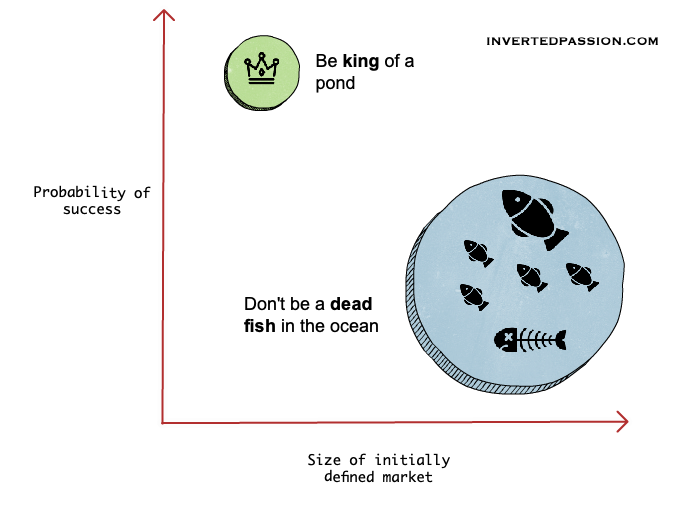It’s common for entrepreneurs to cast a wide net early on and imagine their market to be huge. The logic goes something like this: if the market is worth a hundred billion dollars, then even if 1% of it is captured, the company will be making a billion dollars.
All this sounds good in theory but in practice, it never works this way.
Why would the market leader – the big fish in the ocean – let you take even 1% of the market? In fact, as soon as your startup shows first signs of success, the big fish will do whatever it can to crush you and snatch whatever market share you may have won by that time.

To avoid head-on competition with the big fish and getting eaten by it, a smart entrepreneur defines the initial market as narrowly as possible.
To define the market size, instead of going top-down and taking an arbitrary percentage of it, you need to go bottom-up and actually count the number of customers that your startup is uniquely positioned to capture. Facebook’s initial customer base was a few thousand Harvard University students. Their product initially was a perfect-fit just for Harvard University, and therefore displaced the incumbent Myspace in that market pretty soon. Investors like entrepreneurs who show them a big vision but they like entrepreneurs who show specificity even more.
All big markets have niches that are underserved by established market leaders because their products try to serve large markets. A product initially targeted on these niches can replace established products by providing superior value. Such niches are also often called beachhead markets because they provide an entry point into the large market and provide an initial shielding from competitors as market leaders discount such opportunities as too small for them to care. This gives the much-needed breathing space for entrepreneurs to build a business and an organization with relative peace. The first-mover advantage is overrated anyway.
Beyond providing a laser-sharp product-focus, a narrow market also allows for laser-sharp distribution and marketing. Think about it. If the entirety of your potential market is Harvard University students, to get the word out, you can simply stick posters all over the campus. But what if the entire world is your potential user base. Where would you start sticking the posters and would you have enough posters doing that anyway?
A common fear that entrepreneurs have is that if they define their market narrowly, they’ll undershoot and build a small business. This fear is unfounded. A number 1 position in any market, no matter how narrow, often translates into a big enough business.
Not all businesses have to and can be Google, Apple, Microsoft, or Amazon. Such huge businesses are an exception, not the norm. What usually happens is that most businesses keep on using their #1 position in a narrow market to expand into adjacent markets and hence always keep on growing at a steady pace.
Ask yourself would you rather have a business that makes money and grows steadily or a dream of a huge business that has low chances of happening? If you want the former, define your market as narrowly as possible. Count your customers one by one bottom-up, rather than as a top-down percentage of the population.
Remember: it’s better to be king of a niche than a nobody in a vast ocean.
This essay is part of my book on mental models for startup founders.
Join 150k+ followers
Follow @paraschopra